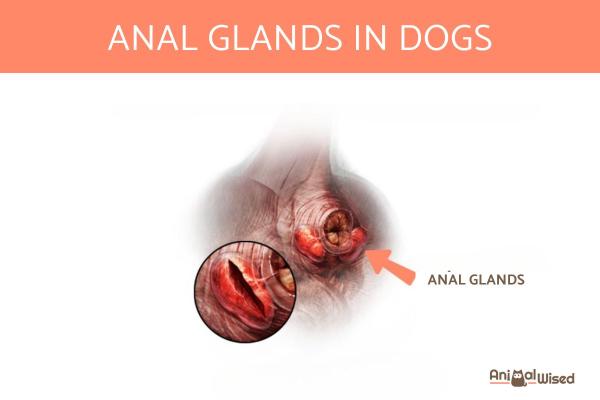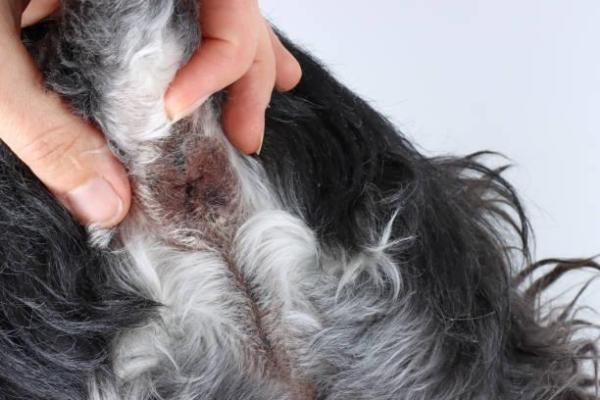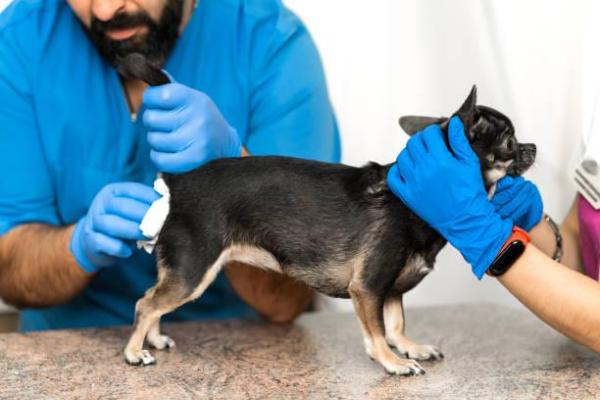What Is Anal Sacculitis in Dogs?



See files for Dogs
Anal sacculitis is a condition affecting dogs that occurs when the anal glands become obstructed or infected. This can lead to discomfort, pain, and difficulty defecating. While anal sacculitis can be uncomfortable for dogs, it's usually treatable with proper veterinary care. If you notice your dog exhibiting symptoms like scooting, licking at the anus, or difficulty defecating, it's important to consult with your veterinarian.
This AnimalWised article will explore the symptoms, causes, diagnosis, and treatment options for anal sacculitis in dogs.
What is sacculitis in dogs?
During defecation, dogs not only release feces but also a thick, smelly fluid produced by their anal glands. These glands are located internally around the anus within small sacs. The fluid serves important functions, such as marking territory and facilitating communication between dogs, which is why dogs often sniff each other's hindquarters when they meet.
Under normal conditions, this fluid is naturally expelled during defecation. However, the ducts that release this fluid can sometimes become blocked due to inflammation, leading to a buildup. This accumulation can cause discomfort, itching, and even constipation in some cases.
If the fluid continues to build up and the inflammation persists, it can lead to a secondary infection, potentially resulting in cellulitis or abscess formation. This condition, known as sacculitis, is relatively common in dogs and tends to recur over time, often affecting one or both glands.

Symptoms of sacculitis in dogs
The symptoms of sacculitis in dogs can vary depending on whether there is just inflammation with secretion buildup or if an infection has also developed. Common clinical signs that may indicate sacculitis in dogs include:
- Itching or pruritus around the anus: dogs may frequently scratch or rub the area.
- Licking or biting the anal area: this behavior is often a sign of discomfort.
- "Sledging" or scooting: dragging the anus along the ground, often using the front legs.
- Fresh blood in the stool (hematochezia): this can occur due to irritation or injury to the anal glands.
- Difficulty defecating (dyschezia): straining or showing signs of pain while defecating.
- Constipation: trouble passing stool due to discomfort or swelling.
- Painful inflammation or swelling in the perineal area: this can make the area tender to the touch.
- Fever: if an infection is present, the dog may develop a fever.
- Anal or perineal abscesses: in severe cases, abscesses may form, leading to more intense pain and swelling.
- Decreased appetite: pain and discomfort may cause the dog to eat less than usual.
Is your dog experiencing anal bleeding? Learn more about potential causes and treatment options in our other article.

Causes of sacculitis in dogs
The causes of sacculitis in dogs are varied, but most cases of anal gland fluid retention can be attributed to one or more of the following factors:
- Lack of dietary fiber or fatty acids: these components are essential for maintaining healthy intestinal transit and ensuring stools have the right consistency. Stools that are too hard due to insufficient fiber or dehydration can irritate the rectal area, making it difficult for the anal glands to expel their fluid properly.
- Advanced age or pregnancy in females: older dogs and pregnant females are more prone to fluid accumulation in the anal glands, which increases the risk of sacculitis and the hardening of gland contents.
- Sudden changes in diet: abrupt dietary changes can lead to gastrointestinal issues that inflame the rectal mucosa, thereby interfering with the normal functioning of the anal glands.
- Constipation: As noted earlier, hard stools can irritate the rectal area, leading to inflammation around the anal glands and potentially causing sacculitis.
- Diarrhea: Frequent episodes of loose stools can also irritate and inflame the rectal area, increasing the risk of sacculitis by disrupting the normal expulsion of glandular fluids.
These factors contribute to the likelihood of sacculitis by affecting the normal expulsion of anal gland fluids, leading to discomfort and potential complications if not addressed.
Concerned about your dog's excessive anal licking? Learn about potential underlying issues and solutions in our other article.
Diagnosis of sacculitis in dogs
To diagnose anal sacculitis in dogs, a thorough physical examination is crucial for identifying the issue. When symptoms suggest sacculitis, it's also important to consider and rule out parasitic infections that might present similarly. In some cases, a sample of the discharge may be collected and analyzed under a microscope to identify any underlying infections or abnormalities.
However, most cases of sacculitis can be easily diagnosed through a routine examination of the dog's anal area. The veterinarian will insert a gloved finger into the rectum to manually express the anal sacs. This will help assess if they are impacted, infected, or inflamed.
It's important to note that palpation and manipulation of the anal glands can cause significant pain and discomfort for the dog, often necessitating sedation to perform a proper and thorough examination. Sedation helps to ensure the dog's comfort and allows the veterinarian to assess the extent of the problem without causing undue stress or pain.
Is your dog struggling with constipation? Discover the benefits of a soft diet and how it can help alleviate discomfort
Treatment of sacculitis in dogs
Treating sacculitis in dogs varies depending on the severity of the condition and whether or not it recurs. Here are the most common approaches:
- Mild cases: the affected anal gland(s) can be manually expressed and then flushed with a saline solution. Following this, a solution containing corticosteroids and antibiotics is typically applied to reduce inflammation and prevent infection. Additionally, applying warm compresses to the anal area can help soothe discomfort and promote healing.
- Severe cases: for more serious cases, the sac may need to be opened to thoroughly empty it. Afterward, it is flushed with an antiseptic solution such as chlorhexidine or diluted povidone-iodine. Warm compresses should be applied to soothe the area, and systemic antibiotics are essential to treat the infection and prevent further complications.
- Chronic or recurrent cases: for dogs that experience frequent relapses, a surgical procedure called a sacculectomy, which involves the removal of the anal sacs, is often recommended. This surgery is typically considered when other treatments have failed to prevent the recurrence of sacculitis.
Regular grooming can help prevent anal sac impaction by ensuring the sacs are expressed properly.
Each case should be assessed by a veterinarian, who will determine the most appropriate treatment based on the dog's specific condition.
For a closer look at how to care for your dog’s anal glands, explore our detailed guide.

This article is purely informative. AnimalWised does not have the authority to prescribe any veterinary treatment or create a diagnosis. We invite you to take your pet to the veterinarian if they are suffering from any condition or pain.
If you want to read similar articles to What Is Anal Sacculitis in Dogs?, we recommend you visit our Infectious diseases category.








